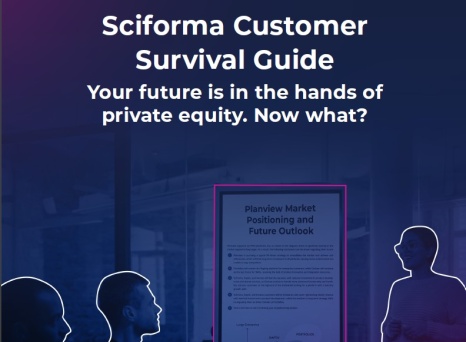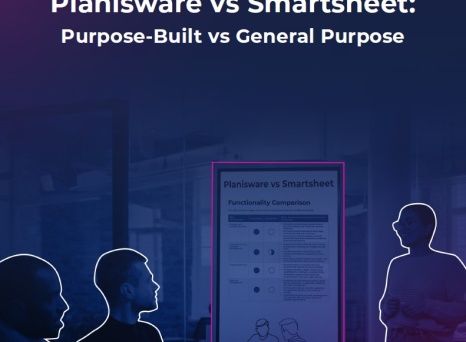Overview
Planisware and Planview are leading providers in the structured work and portfolio management space, serving enterprise and mid-market organizations seeking robust project and portfolio management (PPM) solutions. Both vendors frequently appear on shortlists due to their comprehensive feature sets and established reputations.
However, companies evaluating long-term PPM strategies should look beyond feature checklists. Planisware and Planview differ fundamentally in areas that matter most to sustained business transformation, including customer satisfaction, growth strategy, and the day-to-day experience of working with each firm. This guide provides an in-depth, side-by-side comparison to help organizations make data-driven decision about which provider to choose.
Key Takeaways for Decision Makers
- Market positioning: Understand the relative strengths and market approaches of Planisware and Planview.
- Strategic alignment: Learn which partner aligns best with your organization’s vision for digital transformation, structured work, resource optimization, and adaptive strategy execution.
- Solution buying criteria: Identify key differences and considerations, including platform scalability, integration flexibility, and support responsiveness.
Who Benefits from This Guide?
- Business executives and CXOs: Decision-makers responsible for selecting scalable, governance-focused PPM solutions for long-term growth.
- Enterprise PMO and IT leaders: Leaders tasked with cross-functional investment prioritization, resource utilization, and portfolio impact analysis seeking reliable, best practice-driven platforms.
- Project and program managers: Individuals involved in IT PPM, product development, and industry-specific workstreams, looking for a clear understanding of functional differences to support informed vendor selection.
For organizations undergoing digital transformation or seeking a sustainable competitive advantage by improving their project practices, this guide supports strategic vendor selection by highlighting Planisware and Planview’s unique differentiators, roadmap, and business model philosophy.
Vendor Market Positioning
Planisware and Planview both serve the enterprise and mid-market segments for structured work management solutions. While there is overlap in their target markets and use cases, they differ significantly in platform architecture, growth and go-to-market strategy, integration flexibility, and support structure. Understanding these differences is critical for organizations seeking scalable and sustainable project portfolio management (PPM) solutions.
At-a-Glance Comparison
| Category | Planisware | Planview |
|---|---|---|
| Core Use Case Focus | Unified strategic planning and execution across complex portfolios. SPM, EPPM, digital transformation, and innovation. | Broad PPM/work management suite spanning SPM, Agile delivery, hybrid work, and Lean IT governance. |
| Platforms | Two modular, configurable platforms: Enterprise (enterprise-grade), Orchestra (mid-market). | Portfolios is one of six PPM platforms, with overlapping features and mixed market segment focus. |
| Target Personas | Strategy, IT, business EPMOs, CIOs, IT governance, R&D, and innovation leaders. | EPMOs, IT and Agile/Lean leaders, cross-functional team managers. |
| Industries | Deep domain expertise: life sciences, automotive, manufacturing, energy, government, CPG. | Broad industry reach: technology, financial services, healthcare, public sector. |
| Growth Strategy | Customer-needs-driven, organic product development and innovation. | Typical private-equity-driven growth through frequent acquisitions. |
| Key Capabilities | Unified data model, robust financial modeling, built-in strategic planning, integrated user experience, out-of-the-box value. | Expansion through M&A results in multiple platforms, numerous separately licensed add-ons (Agile, VSM, ideation, EA). |
| AI Capabilities | Embedded forecasting, scenario modeling, and automated decision support. | Wide assortment of AI tools (e.g., Aptage, Copilot); not fully unified across portfolio. |
| Go-to-Market Strategy | Consultative sales, high-touch vertical solutions focus, partnership approach. | Multi-product sales engine, strong emphasis on cross-selling across varied portfolio. |
| Deployment | Highly configurable delivery (minimal customization required), cloud and on-premise options. | More complex configuration needs, most platforms cloud-only, heavy integration/external setup needed. |
| Service & Support | Significant edge in technical support quality, local and in-region support, every customer has a dedicated CSM. | Support is fully offshore (India), long resolution times, dedicated CSMs reserved for top-tier accounts. |
Customer Satisfaction Ratings: Gartner Peer Insights
Customer feedback, industry recognition, and independent ratings provide direct insight into the real-world performance of project portfolio management (PPM) platforms. Planisware consistently outranks Planview across all major product and service categories, reflecting superior customer satisfaction, usability, and capabilities.
- According to recent Gartner Peer Insights data, Planisware has at least a 0.5-point advantage in the majority of service categories, including strategic portfolio management, end-user experience, and integration quality.
- Planisware was recognized as the 2024 Gartner Peer Insights Customers’ Choice for Strategic Portfolio Management - a recognition Planview has never achieved.
- Customer willingness-to-recommend scores further reflect market sentiment: Planisware scores a 90, compared to Planview’s 55.
These distinctions underscore Planisware’s leadership in customer satisfaction, support quality, and overall value for enterprise and strategic portfolio management buyers.
| Category | Planisware | Planview |
|---|---|---|
| Overall Rating | 4.4 | 4.0 |
| Overall Product Capability | 4.7 | 4.1 |
| Demand Management | 4.6 | 4.1 |
| Project and Time Management | 4.5 | 4.2 |
| Resource Management | 4.5 | 4.3 |
| Portfolio Management | 4.6 | 4.3 |
| Collaboration | 4.2 | 3.6 |
| Reporting Management | 4.1 | 3.9 |
| User Security Management | 4.6 | 4.1 |
| Usability | 4.2 | 3.7 |
| Resource Capacity Planning | 4.5 | 3.9 |
| Evaluation/Contracting | 4.4 | 4.0 |
| Pricing Flexibility | 4.2 | 3.8 |
| Ability to Understand Needs | 4.6 | 4.0 |
| Integration/Deployment | 4.4 | 4.0 |
| Ease of Deployment | 4.3 | 3.8 |
| Quality of End-User Training | 4.2 | 3.9 |
| Ease of Integration | 4.4 | 3.7 |
| Availability of Third-party Resources | 4.6 | 3.7 |
| Service Support | 4.3 | 4.0 |
| Timeliness of Vendor Response | 4.5 | 4.0 |
| Quality of Technical Support | 4.6 | 4.0 |
| Quality of Peer User Community | 4.4 | 4.0 |
Notes: The above categories are where Planisware has a full half-star (0.5 point) advantage over Planview. Results data reflects the most recent data available prior to publishing this report (August 1, 2025).
Strategic Partner Considerations
Part 1: Partnering with PE-Backed Vendors
When evaluating long-term project portfolio management (PPM) partners, vendor ownership dynamics and strategic priorities matter. Planisware, as a publicly traded company, offers customers transparency and stability, with financial and product roadmaps focused on sustainable value, not short-term investor returns. By contrast, Planview is backed by private equity (PE), having changed ownership across there major PE firms since 2013 (Thoma Bravo → Vista Equity → TPG/TA). This has led to frequent acquisitions, shifting priorities, and platform complexity.
The table below lists common concerns of business customers when a strategic software supplier has been acquired by private equity firms and makes suggestions for how to protect yourself from its potential negative impacts.
| Typical Concern | Potential Business Impact | Recommended Actions |
|---|---|---|
| Product investment slowdown | Slower roadmap delivery, fewer enhancements; innovation de-prioritized for cost reduction. | Conduct deep due diligence on roadmap stability, innovation bandwidth, and strategic investment plans. |
| Price increases or forced bundling | Higher pricing, bundled products, less negotiation flexibility; risk of unexpected cost escalations. | Negotiate robust SLAs and long-term pricing locks to protect investments. |
| Customer support degradation | Outsourcing, shrinking support teams, longer resolution times, slower workflows. | Monitor SLA compliance, demand strong support terms, regularly review vendor performance. |
| Strategic shifts or exit planning | Misalignment with evolving customer needs, risk of rapid ownership change or market exits. | Develop scenario plans for vendor disruptions; evaluate competitive alternatives regularly. |
| Loss of product vision and culture | Leadership turnover, cultural shifts, diminished platform commitment, user adoption at risk. | Track organizational changes closely; assess executive turnover’s impact on product continuity. |
| Integration uncertainty | Forced migration, platform mergers; risk of disruption and data portability issues. | Review exit clauses, plan for re-platforming, audit data portability requirements. |
Part 2: Can You Trust Planview?
In page published on its website, Planview falsely claims they support 12 key capabilities that Planisware does not. Not only does Planisware support all these capabilities, but according to customers (see Gartner® Peer Insights™ results above), Planisware provides a superior offering, by a significant margin in most cases, in every comparable product and service category.
What trust can you put in any marketing claims from Planview?
Summary & Conclusions
Planisware and Planview compete closely in the enterprise and mid-market segments for structured work and portfolio management solutions, often offering similar core functionalities. However, when organizations evaluate these vendors as strategic partners, several decisive factors favor Planisware:
- Customer Satisfaction
According to Gartner Peer Insights, Planisware consistently earns higher satisfaction scores than Planview across all major performance and experience metrics, including a 90 willingness-to-recommend versus Planview’s 55. - Growth Strategy
As a public company, Planisware’s roadmap and financials are oriented toward sustainable growth and customer success, with a rational, unified platform strategy and no costly add-ons to achieve full functionality. In contrast, Planview operates six platforms and at least 13 separately licensed products, mostly acquired rather than developed organically. Its private equity-backed, M&A-driven growth strategy - focused on an exit - raises customer risks and questions:- Will technical debt continue to limit innovation?
- Will stretched shared services (consulting, support, customer success) further erode the user experience?
- Will declining customer satisfaction persist due to customer confusion over product target use cases and over-lapping functionality, as well as usability issues tied to multiple UIs/UXs?
- Trust & Ease of Doing Business
Planisware’s reputation for trust, partnership, and responsive support is well validated in Gartner Peer Insights and user feedback. Planview’s challenges around customer alignment, support accessibility, and product clarity are recurring customer themes:- Understanding customer needs: Planview trails Planisware markedly in this critical metric.
- Professionalism: Reports of misleading marketing claims and overly aggressive sales tactics.
- Customer practices: Limited and offshore-only support, rigid pricing, charging for unused support hours, and restricted access to customer success managers (CSMs).
- Ease of deployment and integration: Planview struggles to match Planisware’s reputation for high quality and responsive onboarding and technical support.
Next Steps
If you are actively considering Planisware or Planview as a strategic project portfolio management partner, follow these recommendations:
- Use this guide as a reference to clarify vendor fit with your business drivers and strategic objectives.
- If you have concerns about private equity ownership and its impact on future support and innovation, revisit the strategic partner considerations outlined above and seek clear contractual commitments.
- When you are ready to evaluate Planisware’s distinct advantages - including integrated, configurable solutions and proven customer experience - contact the Planisware team to discuss your requirements and arrange a demonstration tailored to your goals.
Appendix: Planview Portfolios Add-On Licensing Matrix
The table below highlights a critical differentiation: Planview Portfolios requires separate licenses for specialized capabilities, while Planisware Enterprise delivers all core features within a single, integrated platform license.
| Add-On Product | Integration Status | Separately Licensed? | Notes |
|---|---|---|---|
| Planview Enterprise Architecture Capability & IT Planning (Troux) | Productized | Yes | Licensed module; not bundled by default |
| Planview IdeaPlace Ideation Management (Spigit) | Productized | Yes | Separate product connected via Hub or Open Data Protocol |
| Planview Aptage AI/ML Forecasting | Embedded | Yes | Requires licensing; sometimes included in premium tiers |
| Planview AgilePlace Agile/Kanban Execution (AgilePlace, LeanKit) | Productized | Yes | Standalone tool with connectors |
| Planview Roadmaps Strategic Planning / Visualization (native) | Embedded | Yes | Separately licensed module |
| Planview Viz Value Stream Flow Metrics (Tasktop Viz) | API / Hub | Yes | Sold separately; consumes data across Hub and Agile tools |
| Planview Advisor Scenario & Portfolio Simulation (native) | Embedded | Yes | Separate license for financial modeling |


